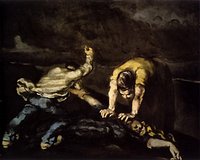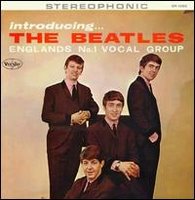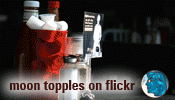What isn't in the pictures is the pictures
My long walk on Tuesday netted almost a quarter of all the shots on my Flickr page (the 45 or so black and white shots on the first few pages), but most of what bowled me over was stuff I wasn't able to photograph: the contents of the National Gallery and the National Portrait Gallery.
There is a rather large exhibit on now of Cezanne's work at the National Gallery, entitled "Cezanne in Britain." It's a pretty thorough career retrospective, so as you stroll through the rooms, you can actually see him changing as an artist, which is pretty cool. Early on, he was drawn to some pretty dark subject matter, and his "The Murder" (1870) is an almost perfect example of what might be referred to as anti-impressionism. While Impressionists called themselves "light painters" and revolutionized the way light is portrayed on a canvas, "The Murder" is all about darkness. He seems to be trying to make the painting as dark as possible while still making the figures visible. I was also especially fond of his "Autopsy (Preparation for the Funeral)" (1869) and "The Abduction" (1867).
Early on, he was drawn to some pretty dark subject matter, and his "The Murder" (1870) is an almost perfect example of what might be referred to as anti-impressionism. While Impressionists called themselves "light painters" and revolutionized the way light is portrayed on a canvas, "The Murder" is all about darkness. He seems to be trying to make the painting as dark as possible while still making the figures visible. I was also especially fond of his "Autopsy (Preparation for the Funeral)" (1869) and "The Abduction" (1867).
They don't allow photography anywhere inside the building, and a trip to the gift shop made me feel much better about that. Even the professional-quality reprints they have to offer completely fail to capture a good painting well. The colors aren't quite right, the depth and the texture are completely missing. The little gift kiosk for the Cezanne exhibit focuses not surprisingly on his later works, the pretty ones, the landscapes mostly. And these are lovely as well, but I would have loved a postcard of "The Murder." The thumbnails I'm providing really don't serve as anything more than the most basic of illustration. I could have probably spent a couple of days in the Gallery, but instead focused mostly on the impressionist and modern works they had on offer. Again, no photograph or reprint seems to be able to recreate the visceral thrill I got rounding a corner and seeing a luminous Monet taking up a third of the wall. Or "Van Gogh's Chair" up close, where you can see the layers and the brushstrokes. There was a breathtaking water study called "Lake Keitele" by Akseli Gallen-Kallela, of whom I had never heard (I freely admit I don't know a whole lot about paintings or painters).
I could have probably spent a couple of days in the Gallery, but instead focused mostly on the impressionist and modern works they had on offer. Again, no photograph or reprint seems to be able to recreate the visceral thrill I got rounding a corner and seeing a luminous Monet taking up a third of the wall. Or "Van Gogh's Chair" up close, where you can see the layers and the brushstrokes. There was a breathtaking water study called "Lake Keitele" by Akseli Gallen-Kallela, of whom I had never heard (I freely admit I don't know a whole lot about paintings or painters).
I next headed to the National Portrait Gallery, which focuses (obviously, I suppose) on portraits of famous and infamous Britons throughout time, set up more or less chronologically. I made my way through the Tudors pretty quickly (their fame isn't drawn from their looks or the skill of their artisans). I sat and wrote a while on a spacious green leather sofa under a painting of George Washington in a section called "The Struggle for America." This wasn't so much out of patriotism as there not being a lot of other seats on hand. They had a special Beatles exhibit I hadn't known would be there which featured some pretty cool shots, mostly candids, of the Fab Four from throughout the 60s. One of the things they had in the "rare" section was the album cover from Introducing the Beatles, which came out in America in 1963 on Chicago's own VeeJay records and flopped terribly. It has a slightly altered version of the track list from Please Please Me. I bought a copy at a garage sale in 8th grade and, not knowing its significance, proceeded to play it into oblivion. In the shape in which I originally found it, it could easily be worth thousands of dollars today. I console myself with the idea that preserving and selling is not really what records are for. They also had outtakes from the Abbey Road cover and the psychedelic Avedon prints you see even today in poster shops.
They had a special Beatles exhibit I hadn't known would be there which featured some pretty cool shots, mostly candids, of the Fab Four from throughout the 60s. One of the things they had in the "rare" section was the album cover from Introducing the Beatles, which came out in America in 1963 on Chicago's own VeeJay records and flopped terribly. It has a slightly altered version of the track list from Please Please Me. I bought a copy at a garage sale in 8th grade and, not knowing its significance, proceeded to play it into oblivion. In the shape in which I originally found it, it could easily be worth thousands of dollars today. I console myself with the idea that preserving and selling is not really what records are for. They also had outtakes from the Abbey Road cover and the psychedelic Avedon prints you see even today in poster shops.
Obviously, there was a lot more: paintings, sculptures, a bust of Alexander Pope which made me think of my brother. But this post is rather long already, and I figure an overview is enough.











1 comment:
I suppose it also isn't really in the best interest of a museum to put out really good reproductions, because then you don't have to visit them.
Post a Comment